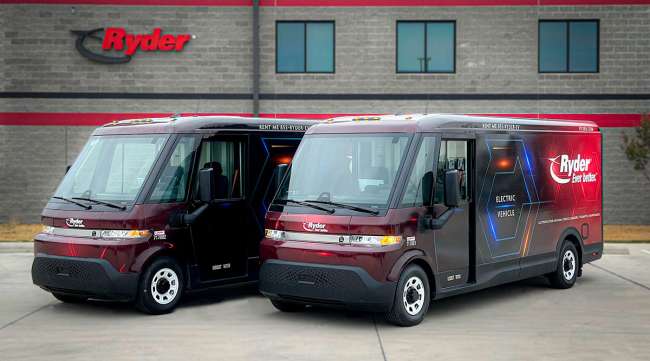Staff Reporter
Ryder: Switching to a Class 8 EV May Double Vehicle Costs

[Stay on top of transportation news: Get TTNews in your inbox.]
Ryder System Inc. may have plans to introduce thousands of electric vehicles to its fleet, but a new analysis by the leasing and logistics specialist indicates the business case for swapping a diesel or gasoline van or truck for an EV is shaky for much of the trucking industry.
Worse still, mandates to introduce EVs before enough infrastructure is in place and vehicle costs decrease considerably could hurt U.S. supply chains and the trucking sector, Ryder warned.
Using data from the Miami-based company’s dedicated fleet operations, Ryder calculated that the annual total cost to transport (TCT) using an EV rather than a vehicle with an internal combustion engine could double, costing as much as $330,000 more to operate.
Ryder Supply Chain Solutions ranks No. 8 on the Transport Topics Top 100 list of the largest logistics companies in North America and No. 9 on the TT Top 100 list of the largest for-hire carriers.
In April 2023, Ryder announced plans to introduce 4,000 BrightDrop Zevo 400 and Zevo 600 vans to its lease and rental fleet through 2025. In September, Ryder deployed its first Zevo 600s at four company facilities in California, Texas and New York.

Sanchez
“While Ryder is actively deploying EVs and charging infrastructure where it makes sense for customers today, we are not seeing significant adoption of this technology,” CEO Robert Sanchez said. “For many of our customers, the business case for converting to EV technology just isn’t there yet, given the limitations of the technology and lack of sufficient charging infrastructure. With regulations continuing to evolve, we wanted to better understand the potential impacts to businesses and consumers if companies were required to transition to EV in today’s market.”
The cost of running an EV rather than retaining a gasoline or diesel van or truck is likely to rise by as much as 114%, Ryder calculations focused on California and Georgia show.
As a result, Ryder’s “Charged Logistics: The Cost of Electric Vehicle Conversion for U.S. Commercial Fleets” study suggested a renewed focus on expanding EV payload and range to match ICE vehicles while keeping the cost of EVs comparable to provide an economic advantage.
Electric Vehicle Total Cost to Transport Analysis
The analysis also concluded that regulators, vehicle manufacturers, technology innovators and other transportation companies needed to work more closely on ramping up the infrastructure required to support EVs.
In addition, seemingly in a warning to California Gov. Gavin Newsom and President Joe Biden, Ryder admonished politicians at all levels that mandating an EV transformation at the moment could see U.S. supply chain disruptions as well as crippling inflationary pressures on goods moved by truck.

Newsom
By 2025, 10% of Ryder’s box trucks, vans, yard tractors and light-duty package delivery vehicles must be zero-emission in California, and a matching percentage of work trucks and day cab tractors must be by 2027 under the Advanced Clean Fleets regulation.
Ryder’s analysis showed a light-duty Class 4 EV transit van is expected to see an annual TCT increase of about 3% or $4,935 in California, rising to around 22% or $47,568 for a Class 6 medium-duty straight truck and 94% or $314,598 for a Class 8 tractor.
For the Class 8 semi, the equipment cost rockets around 500% to $248,438 a year, while general and administrative costs, such as insurance or California Vehicle Code requirements, jump around 87% to $102,041.
To retread or not to retread, that is the question. For some maintenance managers, the debate between purchasing new tires or retreads is constant. In this episode, host Michael Freeze finds answers about tires with Alex Aguilar, senior training specialist at Bridgestone Americas. Tune in above or by going to RoadSigns.ttnews.com.
Cost increases are even greater outside California, which leads the nation in incentives for switching to alternate fuel vehicles.
Ryder assessed costs for vans and trucks in Georgia. It found Class 4 TCT rose about 5% or $7,927 to $163,967, Class 6 TCT increased by just under 28% or $53,414 to $247,181, while Class 8 TCT jumped nearly 114% or $331,257 to $622,438.
“There are specific applications where EV adoption makes sense today, but the use cases are still limited. Yet we’re facing regulations aimed at accelerating broader EV adoption when the technology and infrastructure are still developing,” said Karen Jones, Ryder head of new product development.

Jones
Ryder in December revealed the initial customers for its RyderElectric+ turnkey EV fleet: Pompano Beach, Fla.-based Land ‘N’ Sea Distributing, a marine and recreational vehicle parts distributor, and Servientrega International, a Bogota, Colombia-based parcel logistics carrier with operations in Miami. Land ‘N’ Sea will lease Zevo 600s and Ford E-Transit vans, while Servientrega will deploy Zevo 600s.
Ryder offers a range of EVs for lease beyond the BrightDrop and Ford vans, including Navistar’s International eMV Series trucks, Lonestar EVs with Dana’s electric powertrain, and Freightliner’s MT50e vans, medium-duty eM2 and heavy-duty eCascadia.
However, said Jones, “Until the gap in TCT for heavier-duty vehicles is narrowed or closed, we cannot expect many companies to make the transition; and, if required to convert in today’s market, we face more supply chain disruptions, transportation cost increases and additional inflationary pressure.”
Want more news? Listen to today's daily briefing below or go here for more info:





